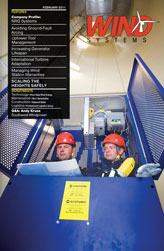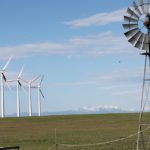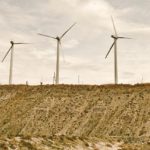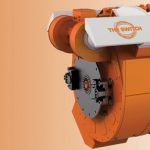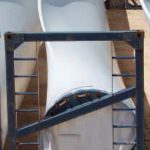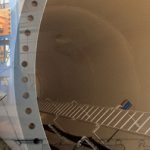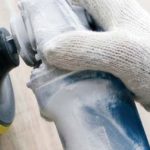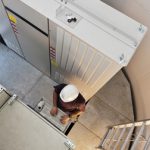At Avanti Wind Systems we work to design and manufacture the best work cages and fall protection systems currently available on the market, but technicians still must be trained and the systems inspected and maintained at least once each year. This is not only a legal requirement, but also a necessary safety precaution for technicians working in towers. Although there are some variations between states, U.S. law requires owners to perform annual inspections and to keep a certification journal including dates and detailed descriptions of the testing methods utilized. This journal must be present whenever the authorities perform a check. A description of these safety devices will not only make their utility clear, but will aid the owner in conducting these inspections.
Designing for Wind
An Avanti work cage allows technicians to avoid climbing up and down the ladder mounted inside of the tower. The cage will carry employees and their tools quickly and safely to the turbine nacelle. The system has also been designed so that it can be used during the construction phase, which means that equipment can be transported within the tower and to a platform close to the nacelle inside of the cage. It can be stopped at any point along its path, and when the doors are opened the drive mechanism is disabled and the technicians can work safely from the cage or climb out onto the ladder. Most Avanti work cages can carry two technicians and their equipment, and they can be used in most types of turbine towers that have been prepared for them. Avanti engineers are constantly developing new work cage systems to meet all industry needs. Figure 1
Avanti Wind Systems has also developed a ladder system with a pre-mounted fall protection system. It is a statutory requirement that all ladders in wind turbine towers should be equipped with a fall protection system that prevents service technicians falling from the ladders if, for instance, they lose their footing or suddenly become ill. The fall protection system stops the service technician after falling a few centimeters, and it remains locked until either the technician can continue alone or can be helped by colleagues. The system is based on a rail in the middle of the ladder. The service engineer’s harness is fitted with a click-on runner that then attaches to the rail. The runner is fastened to the engineer’s harness with a carabineer of the same type as used by rock climbers. The runner can be clicked onto the fall protection system anywhere on the ladder.
As the Avanti fall protection system is designed with a fixed rail on the ladder, several technicians can use the system simultaneously. When using wire-based systems, a technician must wait until his colleague has reached the nacelle before he can use the system himself. The Avanti system has been approved so that one technician can click onto the system every six meters. In other words, as soon as one technician is six meters up the ladder, the next one can start climbing. Figure 2
Avanti has also designed a system that makes it easier for technicians to climb towers. In simple terms, Avanti’s climb assistance is an endless rope that runs from the bottom to the top of towers. It is connected to a motor at the base of the tower, and here the engineer can set the system to a pull force between 30 and 40 kilos. When the technician links to climb assistance with a rope grab and gently pulls the rope, the system takes up the selected bodyweight in kilos during the entire ascent and descent. If the technician stops climbing the system stops as well, and then starts again after a gentle pull of the rope. The system reduces the risk of injuries to engineers’ knees, arms, shoulders, and feet.
Avanti’s climb assistance can be installed in both new and existing towers. In fact, Avanti has installed many climb assistance systems in older towers throughout the world. Older turbines must be serviced more frequently, and this means many hard climbs for technicians on ladders. This is why many owners of older towers decide to install the new system. Climb assistance is not an anti-fall protection system, however. It is merely an aid for engineers, and it must always be used together with an approved anti-fall system. The independent, international test institute Force Technology has approved the simultaneous use of the two systems, as they function perfectly together. This is an additional guarantee of safety.
Passing the Test
Our warranty for work cages, ladders, and climb assistance also requires test and inspection at least once each year by Avanti or personnel that we have trained. Turbine owners naturally accept that all the equipment in towers has to be correctly installed by authorized personnel. But a wind turbine tower is also a place of work, and in contrast to most other workplaces owners sometimes forget that safety equipment has to be tested regularly.
As important as this testing is, proper training is also critical. Every year Avanti Wind Systems trains several thousand wind turbine industry employees throughout the world, either at the Avanti training centers or onsite at wind farms where the employees are working. It also provides closed courses for employees of the same company, or open courses in which anyone can participate. Not many people doubt the importance of having effective safety equipment, but it is equally important that technicians working with the equipment are trained to work with it, and to deal with both dangerous situations and accidents. Figure 3
During the courses, which can run over several days, technicians learn everything about safety in relation to fire, evacuation, and rescue from towers. The courses include theory, but also rely heavily on practical exercises in towers. For example, one compulsory part of the course consists of a course member acting as if he is unconscious while his colleagues fasten him to the safety equipment from the rescue and evacuation unit, which must be in the nacelle, and then lowering first the unconscious subject and then themselves outside of the nacelle.
This is a situation we hope will never occur in the real world, of course, but one that requires special training for any employee who may encounter such a challenge. It’s also important for owner’s to keep in mind that they are responsible for providing this training to anyone who will be relying on this safety equipment, and that the training must be kept current as well.
The Avanti Advantage
Founded in 1885 as the Avanti Ladder Factory in Denmark, scaling heights safely has been the company’s primary concern for more than a century. Avanti Wind Systems has designed work cages, ladder systems, and fall-protection devices specifically for wind technicians for the past 26 years. Today it is the world’s leading producer of work cages and other personal safety systems for use in wind turbines, having supplied more than 12,000 such devices all around the world, totaling more than half of all those installed.
Avanti Wind Systems has recently begun production of ladder systems for wind turbines in the United States. Today the manufacturing of aluminium ladders is taking place near the company’s North American headquarters in New Berlin, which is close to Milwaukee, Wisconsin. The factory is intended to supply the North American wind market. Until now Avanti has manufactured its ladder systems in China and Germany, and these factories will continue manufacturing for the rest of the world.
Avanti Wind Systems has also become a strategic distributor and service partner for Cresto ResQ products in the wind energy industry. Cresto—previously named ResQ—has sold more than 25,000 sets of evacuation and rescue equipment for wind turbine towers around the world. The agreement between Avanti Wind Systems and Cresto means that Avanti has established training and service centers for Cresto equipment in the United States, Germany, Great Britain, Spain, India, Australia, and China, where Avanti already has offices and factories.
As with everything related to wind turbine tower safety, the evacuation equipment must be inspected and tested at least once each year. But Cresto has developed approved packaging that makes it possible to test the safety equipment just once in 10 years. The safety equipment is vacuum packed—that is, put into a foil bag from which all the air is pumped out. When the rescue device, ropes, and other accessories are not in contact with oxygen and humidity they last longer, since the materials cannot wear down. The vacuum packing also safeguards the equipment against the wind turbine tower vibrations. What must still be tested each year in this instance is the integrity of the vacuum seal, in order to make sure that no equipment or mateiral degradation has occurred. If the packing is soft, it’s a sign of a hole in the bag, at which point everything will have to be inspected, tested, and vacuum-packed again.
The Avanti-Cresto partnership also means that the two companies will jointly launch new series of harnesses and other personal protection equipment for technicians working on wind turbine towers. Safety has always been the top priority for Avanti Wind Systems, and the goal is clear: Safe work in wind turbines, anywhere in the world.



















